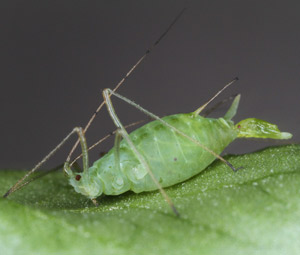May 21, 2010 Research Highlight Biology
Joined at the genes?
Genomic data reveal surprising insights into the essential partnership between a widespread plant pest and a symbiotic bacterium dwelling within its cells
 Figure 1: The pea aphid, Acyrthosiphon pisum, is a crop-destroying pest found throughout the world. © 2010 Atsushi Nakabachi
Figure 1: The pea aphid, Acyrthosiphon pisum, is a crop-destroying pest found throughout the world. © 2010 Atsushi Nakabachi
Aphids leave behind a trail of damaged crops in pursuit of their diet of sap, and a better understanding of the roughly 5,000 known aphid species could prove invaluable in developing safeguards against this agricultural menace. Unfortunately, they represent a particularly complicated family of insects. For one thing, even genetically identical individuals can manifest dramatically different traits depending on environmental conditions. Furthermore, aphids cannot survive on sap alone and depend on the presence of symbiotic bacteria to sustain them.
Accordingly, when the International Aphid Genome Consortium (IAGC) decided to determine the first complete aphid genomic sequence, they targeted the pea aphid, Acyrthosiphon pisum —a reasonably well-understood species (Fig. 1). “As this species has long been used for research, a relatively large amount of biological and genetic information is available,” explains Atsushi Nakabachi, a researcher at the RIKEN Advanced Science Institute and IAGC project leader.
IAGC scientists recently published a ‘first draft’ genome containing 464 million bases of assembled sequence data from A. pisum, and have tentatively identified over 34,000 putative genes—although many are purely hypothetical1. Fortunately, Nakabachi and others have also compiled a library of over 50,000 full-length cDNAs—clones directly derived from expressed genes—which should greatly facilitate genome annotation and characterization of gene function2.
The IAGC has also gathered genomic data from Buchnera aphidicola, the primary pea aphid endosymbiont, and Nakabachi’s team has been steadily working to untangle the complicated relationship between bug and bacterium3. Over the past 100 million years, Buchnera and the aphid have forged a highly interdependent relationship; today, these bacteria lack numerous essential genes whose function appears to be compensated for by their host species, raising questions of whether these genes were incorporated into the aphid genome over the course of evolution.
Careful analysis of the aphid genome revealed at least eight functional aphid genes of apparent bacterial origin, seven of which are highly expressed in symbiont-containing bacteriocyte cells. Unexpectedly, however, all of these appear to originate from non-Buchnera bacteria, suggesting that these symbionts are being sustained by contributions from other species. “Researchers have hypothesized that at least part of ancestral Buchnera genes have been transferred to the host aphid genome, reminiscent of organelles such as mitochondria,” says Nakabachi. “The present study rules out this hypothesis and reveals that the case is more complicated.” He now hopes to uncover more practical details of this genetic partnership, which could eventually reveal useful vulnerabilities to exploit for pest control.
References
- 1. The International Aphid Genomics Consortium. Genome sequence of the pea aphid Acyrthosiphon pisum. PLoS Biology 8, e1000313 (2010). doi: 10.1371/journal.pbio.1000313
- 2. Shigenobu, S., Richards, S., Cree, A.G., Morioka, M., Fukatsu, T., Kudo, T., Miyagishima, S., Gibbs, R.A., Stern, D.L. & Nakabachi, A. A full-length cDNA resource for the pea aphid, Acyrthosiphon pisum. Insect Molecular Biology 19, 23–31 (2010). doi: 10.1111/j.1365-2583.2009.00946.x
- 3. Nikoh, N., McCutcheon, J.P., Kudo, T., Miyagishima, S., Moran, N.A. & Nakabachi, A. Bacterial genes in the aphid genome: absence of functional gene transfer from Buchnera to its host. PLoS Genetics 6, e1000827 (2010). doi: 10.1371/journal.pgen.1000827
